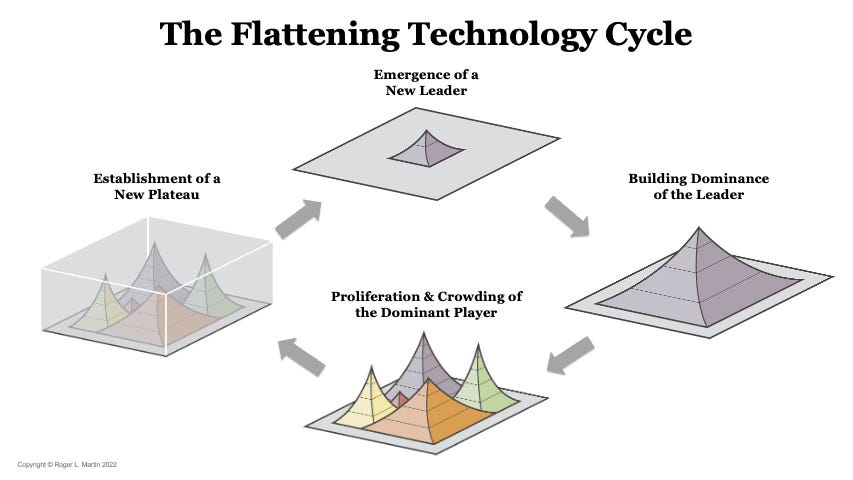Your Startup's Vision May Be Quietly Killing Your Business
The counterintuitive strategy lessons from billion-dollar unicorns that pivoted their way from “cool ideas“ to meaningful missions
Humane AI had $230 million in funding, Apple-pedigree founders… and a stubborn commitment to a vision that led them straight to catastrophic failure.
Critics had expressed skepticism as soon as their first commercial dropped, even as the team worked around the clock to ship. Behind the scenes, the founders, ex-Apple design leaders Bethany Bongiorno and Imran Chaudhri, ruthlessly enforced a toxic positivity culture firing anyone who raised the slightest design, battery life, or functionality problems for “violating company policy.”
Their glitzy launch, and celebrity endorsements led quickly to scathing reviews just a week after Humane shipped their long-awaited device.
Years of experience at Apple and countless successful product launches weren’t enough to save the founders from getting locked into clinging to their vision of a "phoneless future.”

Just months later, Humane’s journey from hot Silicon Valley darling to catastrophic failure was complete as HP bought out the founders to integrate AI into their product line.
But by far the biggest losers in the entire Humane debacle were the customers who paid $700 of their hard-earned money to ride tech’s “bleeding” edge, only to be left with a worthless device just months later.
Even hundreds of millions of dollars in funding and a pair of top-tier founders from one of Silicon Valley’s most beloved product companies weren’t enough to save a vision that attempted to solve a problem customers didn’t have with a product no one wanted.
The Seductive Mission-Vision Trap
There’s an emotional appeal of the idealized startup journey from:
Mission → Vision → Strategy → Plan → $
We naturally gravitate toward big visions that fuel investor expectations, spur rapturous media narratives, and swashbuckling “larger than life” personalities destined from birth to become disruptive startup founders.
However, the uncomfortable truth about almost every successful startup is that their first idea missed a wide margin, requiring them to pivot to survive. Somehow, the survivors were lucky enough to recognize they had to give up on their original vision just in time.
But far more startups weren’t so lucky.
Want to know how to recognize the signs you may be following the wrong dream off a cliff?
Quiz: Stuck in the Vision Trap?
1. You can repeat your mission statement and explain why users “should” want your product but struggle to name your top customer segment and what problem your product solves for them.
Failed founders spend more time perfecting their logo or look than understanding basic customer needs.
2. You do product research to validate, not discover.
Instead of genuinely exploring customer needs with an open mind, you only conduct research to confirm why your idea is so brilliant, and ignore anything that could suggest you might be on the wrong track.
3. Any feedback feels like a personal attack
You become defensive and aggressive when anyone questions your product direction.
That emotional response is a major red flag.
Questions are the Answer
While the vision trap will continue to lure countless founders into failure every day, there is a lifeline that can pull them back from the abyss.
It’s an approach best framed by two simple questions that can prevent billions of dollars worth of startups from following the fate that befell Humane AI.
Two Questions More Powerful Than Any Vision
Successful founders who learn to pivot and survive are better at asking the right questions at the right time than having all the right answers.
Ultimately, it’s the difference between founders who become overly focused on a specific solution or technology, and those who work backwards from real client-centric problems.
Countless founders became obsessed with blockchain technology a few years back, “shoe-horning” it into otherwise lackluster ideas and netting huge VC investments before spectacularly flaming out.
Tech Hype
Blockchain is an excellent example of a brilliant tech solution still searching for that “killer app,” a perfect blend of tech with the right customer problem to solve at the right time.
And the hype cycle is repeating itself now, but AI is turning out to be not only a far more “flattening” but far more useful technology for addressing user needs.

Because uncovering and serving the right users’ unmet needs naturally leads to better pivots.
One of the best lenses to view our strategy lies in two questions initially framed by Roger L. Martin: “Where to Play” and “How to Win.”
Where to Play?
“Where to Play” means being clear about which customers you’ll serve, across which geographical areas, through which channels.
For example, one “Where to Play” could be online gamers who prefer mobile hyper-casual games.
Or Product Managers who need to quickly sketch rough wireframes to share with others for feedback.
How to Win?
“How to Win” is how you’ll create a competitive advantage on your “Where to Play” playing field.
What unique and distinctive differentiation will you offer for which you can charge a price premium?
For our mobile hyper-casual gamers, you could offer mobile-based short game play but allow them to play with others in cross-platform environments.
For our wireframing product manager who needs to quickly sketch an idea, we could make it easy for them to collaborate with others. They could add designers, data people, engineers, or stakeholders to their sketch to collaborate in real time with versioning and commenting features.
The key to creating more effective strategies is to design our “Where to Play” and “How to Win” choices as interlocking, matched sets.
Pivoting through Matched Choices
If we take a closer look at why our startup idea may not be getting traction, it can come down to a basic mismatch between our WHERE and HOW choices.
This will require us to change direction, or the dreaded “p-word”: Pivot.
While pivoting can feel terrifying—like swapping out our plane’s jet engine mid-flight—it’s not a sign of failure but of listening, adjusting, and adapting to survive.
Turning around our situation will require us to quickly design, test, and iterate through several potential matched “Where to Play” and “How to Win” choice sets until we can discover a more appropriate set suited to a specific user segment and their needs.
Working Backwards
It means staying obsessed with specific users’ problems and working backwards from them.
While it may feel like we’re betraying our initial purpose as we shift through different WHERE, HOW and problems, success will depend on us listening to what the market and our users are trying to tell us and not getting locked into any specific solution.
Because our success won’t be based on what we think or hope to be true; it will only hinge on surfacing our underlying assumptions by asking another crucial question.
Strategy’s Most Important Question
The only way to know whether our set of strategic choices is valid is to ask the fundamental question:
What Would Have to be True?
Only by asking what would have to be true can we stress-test the core logic underpinning our set of strategic choices.
For each pair of “Where to Play” and “How to Win” choices, we’ll need to ask “What Would Have to be True?” about:
Customer: How will we expect customer behaviors to change in response to our offer?
Company: Do we have, or can we build, the necessary capabilities and management systems to deliver against these specific “Where to Play” and “How to Win” choices?
Competition: What counter-moves will our competitors make in the response to our strategic choices?
Asking and answering these questions honestly will surface potential gaps in our logic that we can systematically test before we persist follow potentially disastrous directions to failure.
Think of 'What Would Have to be True?' as our startup's early warning alert system.
It lets us run the core of our business plan through an MRI machine that reveals tiny hidden fractures long before they grow into catastrophic faults.
Quibi Forgot to Ask the Question

Quibi was another recent, much-hyped, richly-funded startup stocked with top-tier talent that imploded spectacularly.
Yet for everything Quibi had going for it, their leadership apparently failed to ask the most fundamental “What Would Have to be True?” question:
“It would have to be true that customers would see the value in the unique, mobile-optimized Quibi content created by Hollywood A-Listers, to the point they would subscribe to it and prefer it over anything else available for free on Instagram, TikTok, or YouTube.”
Had Jeffrey Katzenberg and his Quibi leadership team bothered to ask this question, they would have exposed a glaring truth: their target customers simply wouldn't pay for short-form content when billions of free minutes of “good enough” mobile-optimized video content was already available at their fingertips.
Doing some basic user research with the Quibi target audience segment would have revealed this glaring flaw underlying their essential product and business model, and they might have been able to pivot in time.
How have the most successful tech startups bucked this trend and pivoted in time to avoid failure?
Successful Pivots Answer the Right Questions
Most of the apps we use every day began as startups with very different missions before pivoting their way to success:
Instagram pivoted from check-in app to photo platform.
X iterated from podcast directory to social network.
But one of my favorite stories is the path Slack took to achieve their current success.
The Slack Story You Never Knew
Most people aren’t aware that Slack's original “Where to Play” focused on online video gamers, and their “How to Win” began as an online game called "Glitch."
When Stewart Butterfield realized that "Glitch" would never be profitable, he pivoted to see if he could turn his development team’s internal communication tools into a product.
Butterfield never started with a mission to "make work life simpler, more pleasant, and more productive"—he uncovered that "Winning Aspiration" through iteration, experimentation, and close collaboration with users.
When we can stay close to our users and look at our product not as a fixed idea but as something we can iterate to address a unique problem for the right customer effectively, we can gain traction and iterate towards more meaningful missions over time.
The Billion-Dollar Pivot Pattern
The unexpected breakthrough pattern across successful startups, from small, bootstrapped companies to billion-dollar unicorns is simply this:
Great missions grow from innovative and effectively matched “Where to Play” and “How to Win” choices, not the other way around.
Shopify's transformation from a tiny snowboard shop to the Internet’s leading e-commerce platform exemplifies this pattern.
Learning to Pivot
Tobias Lütke didn't jump out of bed one morning inspired with the dream of building the world's leading e-commerce platform.
In the beginning, all he wanted to do was sell the snowboards he was so passionate about. When he couldn't find e-commerce software that met his needs, he built his own from the ground up.
But here's where Lütke's journey veers from those of so many failed founders – when other merchants began asking about his online store solution, he listened. He eventually made the leap from selling snowboards to selling the platform itself as a service.
Each time he got feedback about the assumptions he had coded into his platform and what it could do better, Lütke looked at it as a gift instead of an attack, seeking out the lesson it held, and responding.
Open to Learn
While the Humane AI founders fired employees who raised concerns, Lütke embraced different viewpoints, regardless of where they came from.
This “growth” mindset allowed his small snowboard idea to evolve into something far more impactful.
The more we view successful startups through the lens of these three powerful questions: “Where to Play,” “How to Win,” and “What Would Have to be True?”, the more we’ll see that it doesn’t matter where you start. It’s asking and answering these questions along the way that makes all the difference.
Knowing whether to pivot or persevere then becomes our next billion-dollar question.
And the key to that lies in understanding our product's role in our core users’ needs.
Using “Fit” to Frame Vision
While it can be challenging to measure whether our product is gaining traction in the market, the concept of “product/market fit” can help:
Marc Andreesen framed product/market fit way back in 2007 as:
“...you can always feel product/market fit when it’s happening. The customers are buying the product just as fast as you can make it — or usage is growing just as fast as you can add more servers. Money from customers is piling up in your company checking account. You’re hiring sales and customer support staff as fast as you can. Reporters are calling because they’ve heard about your hot new thing and they want to talk to you about it…”
Andreesen’s description is thrilling, but qualitative and subjective.
Founders need more evidence-based ways of understanding whether they’ve locked in on a solid set of “WHERE” and “HOW” choices and achieved the desired product/market fit before framing their startup’s Mission and Vision.
One effective way to understand this comes thanks to the pioneering work of Sean Ellis.
The Product/Market Fit Formula
Ellis, who ran growth for Dropbox, LogMeIn, and Eventbrite, became obsessed with finding a way to measure product/market fit.
After much trial and error, Ellis designed the PMFSurvey, which asks users
“How would you feel if you could no longer use the product?,” with three potential answers:
Very disappointed
Somewhat disappointed
Not disappointed
After experimenting with hundreds of startups, Ellis discovered that when over 40% of users answered “Very Disappointed,” that was a strong leading indicator that a startup was solving a worthwhile problem for the right people.
This, then, is the sign that the founders have uncovered a way to bridge the gap between what the market is ready for and forming their product’s vision.
The Product Takes on a Life of Its Own
Founders leading teams of talented people committed to solving user problems remain only partly in control of their destiny.
The other part depends on how users respond when they interact with the product.
The questions through which we view startups here can help reduce risk, but they can never guarantee success because we’re dealing with people, who are, at best, “probabilistic” in nature.
Iterating to Give Birth to the Mission
Every startup idea “should” work, in theory. But many of them don’t for a myriad of reasons.
Only by staying curious and close to customers and their needs can they stay flexible and iterate to discover the best approach. It’s a constant give–and–take between users and the product team, continuously iterating and evolving their product, or what Reid Hoffman termed “jumping off of a cliff and assembling a new airplane on the way down.”
Will they pivot through enough of the right ideas to find a viable “Where to Play” and “How to Win” in time?
As they grow and evolve their strengths to meet their users’ needs, startups with more organically-arrived-at missions have the potential to create stronger, more resilient companies than those designed to solve a single set-in-stone mission
Stay Strong on Momentum, Flexible on Direction
Imagine the product Humane AI could have been had the founders actively sought feedback and listened to its employees and users.
They likely would have abandoned their clunky pin and projected user interface for something far more seamless. In contrast, Shopify has not only evolved beyond its single online snowboard shop but continues to evolve its suite of products and services to this day.
The Questions of Strategy
The liberating insight is that letting go of our “perfect” original mission holds the key to discovering other potentially more rewarding missions worth pursuing, both for our users, as well as for our business.
Through the lens of WHERE and HOW, we’ve learned a simple framework for maintaining forward momentum while staying flexible, tempered by strategy’s most important question:
“What Would Have to be True?”
And remember that inspirational missions grow out of matching our WHERE and HOW choices to customer needs, not the other way around.
Because money only comes from one place: paying customers.
Give them something to love, and they’ll be more than happy to reward you with their money, loyalty, and be your best spokespeople.
My Parting Challenge to You
Within the next three days, for the current WHERE and HOW set of choices you’re targeting, write down your three riskiest 'What Would Have to be True?' assumptions, and design one small experiment to test each.
Ideally, at least one test would involve talking to a user.





"The liberating insight is that letting go of our “perfect” original mission holds the key to discovering other potentially more rewarding missions worth pursuing, both for our users, as well as for our business."
SO GOOD
Good insight 😌 Can i translate part of this article into Spanish with links to you and a description of your newsletter?